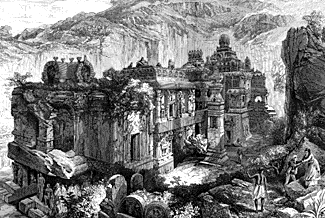| THE CAVES OF ELLORA |
| "The rock-cut temples of Ellora are scarcely less remarkable than those of Elephanta. Ellora is about 180 miles from Bombay, in the domain of the Nizam of Hyderabad. A series of vast halls and galleries, decorated with a profusion of sculpture, has been here cut out of the back or grey basaltic rock of a mountain. This was done about nine hundred years ago, by order of the Rajah Elu in honor of the Hindoo deities, but more especially of Siva or Mahadeo. The surface of the rock was coated with chunam, a fine hard plaster resemblijng porcelain, and was painted of divers [diverse] colors. |
| "One of the most interesting of the rock temples of Ellora is the Kailas, which means the heaven of Siva or Mahadeo. This temples is an exception among the rock excavations of Western India. The others are all cave temples; but the Kailas is a mass of rock cut out of the hillside, and then sculptured in the form of a built temples. The importance of the work may be judged by its size. The hill has been cut into as far back as 400 feet; the temples itself is 300 feet long. The width of the space between the scarps on each side is 185 feet; the highest part of the temples is about 100 feet high. The temple consists of a great hall, with a sanctum at the eastern end for the symbol of Mahadeo. This is, of course, the principal part of the shrine. |
| "The hall if about 66 feet long by 55 feet wide, and 16 or 17 feet high. One might say that the roof is supported by four rows of pillars, but where roof and pillars are all one piece of rock, left by excavation, the propriety of the word 'support' becomes doubtful. In front of the great hall is the house of Nandi, the Bull, which is the wahan, that is to say, the steed, of Siva. It is always placed facing the symbol of the god. In front of this again, and over the entrance, is the Naubat-khana, or music gallery, where in former times, when the place was frequented by votaries, the great drum would be beaten. |
| "The passage into the temple has turns, after entering, to the right and left. On each side formerly stood an elephant; the one on the north still remains, though mutilated. There are also two square columns, which probably were surmounted by the trisul or trident of Siva. The colonnades round the base of the scarps are covered with sculptures of Hindoo mythology. Over the north colonnade is a very fine rock-cut temple, known as the Lanka Cave; over the south colonnade is another, called the Pir Lanka, and a bridge once communicated with it from the great hall of the Kailas, but this has been broken down, and the cave can not now be reached without a ladder. The illustration is taken from the southern side, and shows this broken bridge." |

